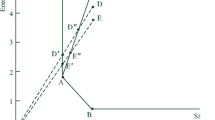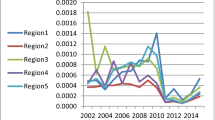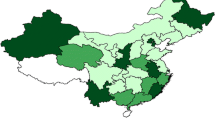Abstract
This study aims to explore the impact of energy prices on energy consumption and energy efficiency using industry data for Taiwan over the period of 1982–2011. A frontier-based framework is proposed with a microeconomic foundation to measure energy efficiency and decompose energy consumption into energy utilization and energy wastage in the short and the long run. We learn that the traditional energy efficiency indicators are essentially ambiguous measures. In contrast, the frontier-based framework can focus the measure on energy relatively specifically and capture the essence of a proper efficiency measure more precisely. The empirical analyses reveal that the values of short- and long-run energy efficiency in the Taiwan manufacturing sector are on average 0.6016 and 0.8040, respectively. Moreover, energy utilization is price inelastic in the short run, but in the long run, it is elastic at −0.79. The energy price elasticity of energy wastage in the short run is −0.61, which is somewhat higher than the −0.52 in the long run. The energy price elasticity of energy efficiency in the short run is 0.077 and that in the long run is 0.144. All the energy price elasticities obtained using the frontier-based framework are lower than those obtained using the common framework of the past without distinguishing the heteroscedasticity between the energy utilization and energy wastage.




Similar content being viewed by others
Notes
The GRG is an algorithm specifically designed to solve nonlinear programming problems and has been used since the seminal work of Abadie and Carpentier (1969). It conceptually searches for the optimization of a nonlinear objective function under conditions of nonlinear constraint. Even if the constraints are inequalities, it converts the constraints to equalities by bringing in surplus variables. The GRG has been proven to be a superior solution in nonlinear programming due to its robustness and efficiency (Bazaraa et al. 1993). For more detail on the GRG, please refer to Abadie and Carpentier (1969).
In Taiwan, 51.4 % of the energy is consumed by the manufacturing-related sector.
References
Abadie, J., Carpentier, J., 1969. Generalization of the Wolfe reduced gradient method to the case of nonlinear constraints. in R. Fletcher (ed.) Optimization, Academic Press.
Adom, P. K., Bekoe, W., & Akoena, S. K. K. (2012). Modelling aggregate domestic electricity demand in Ghana: an autoregressive distributed lag bounds cointegration approach. Energy Policy, 42, 530–537.
Aigner, D. J., Lovell, C. A. K., & Schmidt, P. (1977). Formulation and estimation of stochastic frontier production function models. Journal of Econometrics, 6, 21–37.
Arellano, M., & Bond, S. (1991). Some tests of specification for panel data: Monte Carlo evidence and an application to employment equations. Review of Economic Studies, 58, 277–297.
Atakhanova, Z., & Howie, P. (2007). Electricity demand in Kazakhstan. Energy Policy, 35, 3729–3743.
Battese, G. E., & Coelli, T. J. (1992). Frontier production functions, technical efficiency and panel data: with application to paddy farmers in India. Journal of Productivity Analysis, 3, 153–169.
Bazaraa, M. S., Sherali, H. D., & Shetty, C. M. (1993). Nonlinear programming: theory and applications. New York: John Wiley & Sons.
Blundell, R., & Bond, S. (1998). Initial conditions and moment restrictions in dynamic panel data models. Journal of Econometrics, 87, 115–143.
Coelli, T.J., Rao, E.S.P., O’Donnell, C.J., Battese, G.E., 2005. An introduction to efficiency and productivity analysis (2nd edition). Springer Science & Business Media, New York, USA.
Conrad, K. (2000). An econometric model of production with endogenous improvement in energy efficiency, 1970–1995. Applied Economics, 32, 1153–1160.
Engle, R. R., & Granger, C. W. J. (1987). Co-integration and error correction: representation, estimation, and testing. Econometrica, 55, 251–276.
Fatai, K., Oxley, L., & Scrimgeour, F. G. (2003). Modeling and forecasting the demand for electricity in New Zealand: a comparison of alternative approaches. Energy Journal, 24, 75–102.
Feijoó, M. L., France, J. F., & Hernández, J. M. (2002). Global warming and the energy efficiency of Spanish industry. Energy Economics, 24, 405–423.
Holtedahl, P., & Joutz, F. L. (2004). Residential electricity demand in Taiwan. Energy Economics, 26, 201–224.
Honma, S., & Hu, J. L. (2008). Total-factor energy efficiency of regions in Japan. Energy Policy, 36, 821–833.
Hu, J. L., & Kao, C. H. (2007). Efficient energy-saving targets for APEC economies. Energy Policy, 35, 373–382.
Hu, J. L., & Wang, S. C. (2006). Total-factor energy efficiency of regions in China. Energy Policy, 34, 3206–3217.
Johansen, S. (1988). Statistical analysis of cointegration vectors. Journal of Economic Dynamic Control, 12, 231–254.
Johansen, S., & Juselius, K. (1990). Maximum likelihood estimation and inference on cointegration with applications to the demand for money. Oxford Bulletin of Economics and Statistics, 52, 169–210.
Kumbhakar, S.C., Lovell, C.A.K., 2000. Stochastic frontier analysis. Cambridge University Press, New York, USA.
Levin, A., Lin, C. F., & Chu, C. S. J. (2002). Unit root tests in panel data: asymptotic and finite sample properties. Journal of Econometrics, 108, 1–24.
Moshiri, S. (2015). The effects of the energy price reform on households consumption in Iran. Energy Policy, 79, 177–188.
Narayan, P. K. (2005). The saving and investment nexus for China: evidence from cointegration tests. Applied Economics, 37, 1979–1990.
Ozturk, I., & Acaravci, A. (2010). The causal relationship between energy consumption and GDP in Albania, Bulgaria, Hungary and Romania: evidence from ADRL bound testing approach. Applied Energy, 87, 1938–1943.
Pesaran, H. M. (1997). The role of economic theory in modelling the long-run. Economic Journal, 107, 179–191.
Pesaran, M. H., & Shin, Y. (1998). An autoregressive distributed-lag modelling approach to cointegration analysis. Econometric Society Monographs, 31, 371-413.
Pesaran, M. H., Shin, Y., & Smith, R. J. (2001). Bounds testing approaches to the analysis of level relationships. Journal of Applied Econometrics, 16, 289–326.
Song, B. Z. (2004). Enhancing national competitiveness: does Taiwan have energy strategies? Global Views Monthly, 220, 156–158 (In Chinese).
Tang, C. F., & Tan, E. C. (2012). Electricity consumption and economic growth in Portugal: evidence from a multivariate framework analysis. Energy Journal, 33, 23–48.
Tang, C. F., & Tan, E. C. (2013). Exploring the nexus of electricity consumption, economic growth, energy prices, and technology innovation in Malaysia. Applied Energy, 104, 297–305.
Tang, C. F., & Tan, B. W. (2014). The linkages among energy consumption, economic growth, relative price, foreign direct investment, and financial development in Malaysia. Quality and Quantity, 48, 781–797.
Author information
Authors and Affiliations
Corresponding author
Appendix
Appendix
Rights and permissions
About this article
Cite this article
Chen, KH., Yang, HY., Lee, JM. et al. The impact of energy prices on energy consumption and energy efficiency: evidence from Taiwan. Energy Efficiency 9, 1329–1349 (2016). https://doi.org/10.1007/s12053-016-9426-y
Received:
Accepted:
Published:
Issue Date:
DOI: https://doi.org/10.1007/s12053-016-9426-y




